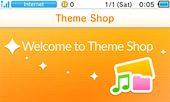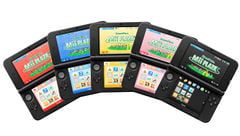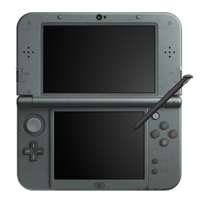New Nintendo 3DS: Difference between revisions
No edit summary |
No edit summary |
||
| Line 28: | Line 28: | ||
===Backwards Compatibility=== | ===Backwards Compatibility=== | ||
The system is backwards compatible with both 3DS, DS and DSi games. When in DS mode, the New 3DS simulates a DSi instead of an original DS so any [[Nintendo DSi#DSi Enhanced Games|DSi enhanced games]] will be given additional features for them to utilize. As with the DSi, Nintendo DS games that used the original DS's [[Game Boy Advance]] slot cannot make use of extensions, which the New 3DS lacks. | The system is backwards compatible with both 3DS, DS and DSi games. When in DS mode, the New 3DS simulates a DSi instead of an original DS so any [[Nintendo DSi#DSi Enhanced Games|DSi enhanced games]] will be given additional features for them to utilize. As with the DSi and 3DS, Nintendo DS games that used the original DS's [[Game Boy Advance]] slot cannot make use of extensions, which the New 3DS lacks. | ||
===Language Support=== | ===Language Support=== | ||
Revision as of 17:41, November 1, 2016
Template:System-Infobox Template:LLQuote
The New Nintendo 3DS is the successor to the Nintendo 3DS produced by Nintendo. One of the console's primary features is an NFC sensor is built-in under the bottom screen, allowing compatibility with the amiibo line of products without needing the stand peripheral. It was released in Japan on October 11, 2014, Australia and New Zealand on November 21, 2014, Europe on February 13, 2015, and the United States on September 25, 2015. On January 6, 2015, selected European Club Nintendo owners were invited to buy New Nintendo 3DS Ambassador Edition, a special pre-release bundle of New Nintendo 3DS, for €199.99, with orders shipped as early as January 7, 2015.[1] It is the handheld counterpart of the Nintendo Switch. The graphical capabilities are likened to that of the Wii, but not on par with the Wii U.
Features
The New Nintendo 3DS[2] was announced on August 28, 2014. In addition to having a more powerful CPU, the New Nintendo 3DS features an improved 3D effect, using the system's gyroscope and cameras to track the location of the player's eyes to sustain the 3D effect. An NFC sensor is built-in under the bottom screen, allowing compatibility with the amiibo line of products without needing the stand peripheral. Two additional shoulder buttons (ZL and ZR) have been added, alongside a second smaller circle pad above the , the same features added to a standard Nintendo 3DS or 3DS XL with the Circle Pad Pro. The
and
buttons have been moved under the
buttons, similar to the Nintendo DS Lite and DSi. In addition, the cartridge and stylus slots have been moved to the bottom of the handheld, and the SD card slot has been replaced by a microSD slot on the back of the system which can be accessed by removing the bottom cover.
The New Nintendo 3DS models also feature removable back covers on the backs of the top and bottom screens, which can be replaced with custom covers purchased separately. The New Nintendo 3DS also features some changes to the Internet application in that it can now play HTML5 videos. Japanese New Nintendo 3DS models have a web filter pre-activated which can only be removed by paying 30 yen, but the preactivated filter is absent on models released outside of Japan.[3] Certain titles, such as the port of Xenoblade Chronicles, are exclusive to the New 3DS systems, and are incompatible with any of the older models.[4] SNES games including Super Mario World have also been released exclusively on the New 3DS's Virtual Console service.
SD Card
A New Nintendo 3DS or New Nintendo 3DS XL come with a 4 GB Micro SDHC Card. However, any SD or SDHC card can be used and with appropriate adaptors, if necessary and compatible.
Battery Life
The package includes a charging cradle along with the standard charging cable (which is the same as that of the DSi, and consequently is compatible with the DSi as well). The battery lasts three to five hours (calculated with minimum settings) while playing standard 3DS or New 3DS games; battery life is affected by brightness, 3D level, and wireless connectivity. To fully charge the battery, it takes approximately three and a half hours, so there is an energy saving mode that can be activated to slightly increase the battery life. When playing DS or DSi games, the battery lasts about 5-8 hours due to some hardware being disabled like the pedometer and HOME Menu.
Multitasking
The New Nintendo 3DS features limited multitasking. Software in use can be suspended with the button any time the software is open (except occasionally during online play) in order to change the screen brightness, switch to another software, check the Friend List if friends are online, browse the Internet, post to Miiverse, organize the HOME menu and check notifications from StreetPass and SpotPass.
StreetPass and SpotPass
StreetPass allows the console to send and receive title data with other consoles within a certain range when it is in sleep mode. Up to twelve titles can have StreetPass activated at once. A notification light on the New 3DS turns green to indicate when StreetPass data has been exchanged. The StreetPass Relay update allows for StreetPass data to be exchanged near official Nintendo Zone hotspots. One New 3DS can StreetPass the same spot or same other New 3DS once every eight hours. SpotPass also allows data exchange but differs from StreetPass in that it requires an Internet connection to be used. A notification light on the New 3DS turns blue to indicate when such data has been downloaded.
Backwards Compatibility
The system is backwards compatible with both 3DS, DS and DSi games. When in DS mode, the New 3DS simulates a DSi instead of an original DS so any DSi enhanced games will be given additional features for them to utilize. As with the DSi and 3DS, Nintendo DS games that used the original DS's Game Boy Advance slot cannot make use of extensions, which the New 3DS lacks.
Language Support
The New 3DS also features enhanced language accessibility. All these languages are included on the European and Australian version of the New 3DS, and the Portuguese language is also included on the American version. Mario games also began including Dutch, Portuguese and Russian settings. However, these languages are available only in European and Australian versions of the games.
Step Counter
The Step Counter works by using the New 3DS's motion sensor to count the player's steps when the New 3DS is closed. Every 100 steps gives the player one Play Coin, which can be used in the AR Games, StreetPass Mii Plaza, and compatible games. Players can receive a maximum of ten Play Coins per day and can hold a maximum of 300 on the New 3DS system. Additionally, every step is logged in the Activity Log.
Themes
Brand new themes were added onto the system for the users to customize their HOME menu. Users were given 5 starting themes, each a different color, with additional themes available for purchase in the new Theme Shop. Additionally, since another theme related update, users are able to set a "shuffle" like mode via theme settings where the user can set his/her favorite themes into slots so each theme is set to their home menu to switch out every time they put the New 3DS into sleep mode or go into an app or game.
|
|
|
|
|
Hardware revisions
New Nintendo 3DS XL
The New Nintendo 3DS XL (New Nintendo 3DS LL in Japan) is a version of the New Nintendo 3DS handheld. Similarly to the Nintendo DSi XL and Nintendo 3DS XL, the New 3DS XL has larger screens: the upper measuring 124 mm (4.88 inches) (making it tied to the 3DS XL as the biggest screen on a Nintendo handheld so far) and the lower measuring 106 mm (4.18 inches), both being 90% larger than the standard New Nintendo 3DS screens. The resolution, however, is the same. Additionally, it is packaged with a 4 GB Micro SDHC card, and the battery has been optimized to last longer. The handheld was released in Japan on October 11, 2014, in Australia on November 21, 2014, and in Europe and the Americas on February 13, 2015.
Gameplay accessories
Stylus
For the New Nintendo 3DS XL and Nintendo 2DS, the stylus more resembles the original Nintendo DS stylus, being a single, solid color and removing the extension feature on the normal model. The stylus for these versions is stored on the side of the handheld, similar to the Nintendo DSlite/DSi.
amiibo
- Main article: amiibo
amiibo are a series of toys-to-life accessories by Nintendo that can be scanned into games using near-field communication technology to add content into games. Originally released for Wii U, Nintendo 3DS and New Nintendo 3DS systems later received amiibo compatibility. New Nintendo 3DS systems feature a built-in near field communicator, activated by placing an amiibo on the Touch Screen.
Software
- Main article: Nintendo 3DS#Software
External links
References
- ^ New Nintendo 3DS Ambassador Editions Already In The Hands Of Lucky Buyers. Nintendo Life. Retrieved January 7, 2015.
- ^ https://www.youtube.com/watch?v=N1cwg6mUhAg
- ^ No Internet Browser ‘filter’ in Australian New Nintendo 3DS models. Vooks. Retrieved January 7, 2015.
- ^ http://www.nintendo.co.jp/nintendo_direct/20140829/index.html



